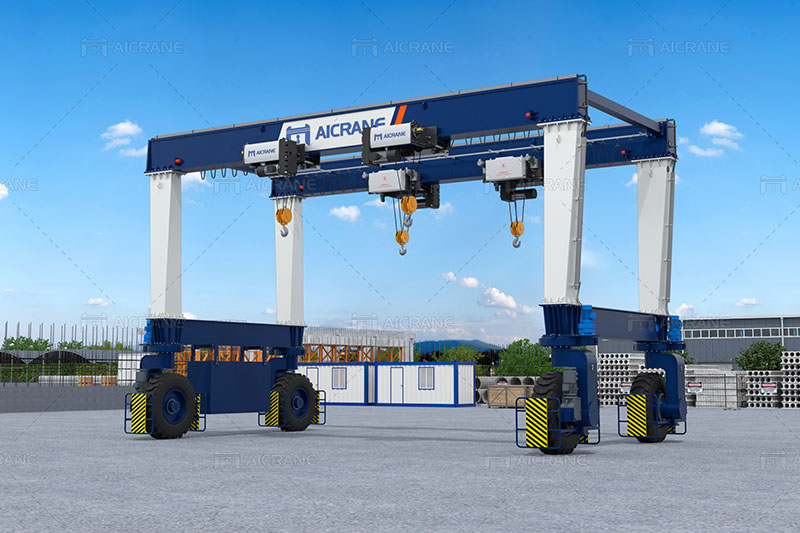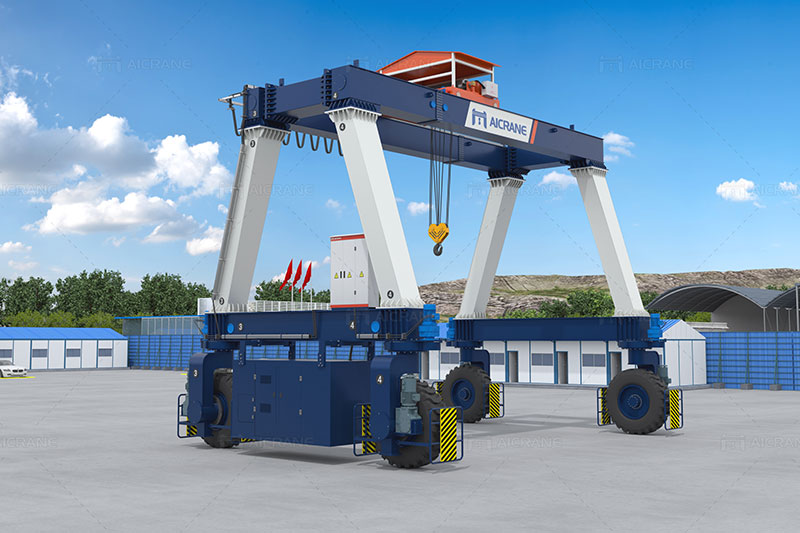Rubber Tyred Gantry (RTG) cranes have become indispensable in various industries, especially in container ports and intermodal terminals, thanks to their unique combination of mobility, flexibility, and lifting power. Designed primarily for handling large, heavy loads such as shipping containers, RTG cranes stand out for their ability to move across wide operational areas with ease, powered by a rubber-tire-based design that sets them apart from their rail-mounted counterparts. In this article, we’ll explore the benefits of RTG crane mobility, steering modes, applications, and how they contribute to efficient port and yard operations.

1. What is a Rubber Tyred Gantry (RTG) Crane?
RTG cranes are mobile gantry cranes that are used primarily in container handling applications to stack, position, and transport containers from one point to another within a container yard. Unlike Rail Mounted Gantry (RMG) cranes that move along fixed tracks, RTG cranes feature large rubber tires, which provide the flexibility to move across container yards or terminals without the constraints of a rail system. This allows for a versatile operation setup in locations where laying tracks may not be feasible or desired.
An RTG crane generally consists of a robust steel frame that supports a hoist system capable of lifting heavy loads, typically ranging from 20 tons to 65 tons. The crane’s design also includes a trolley that moves horizontally, allowing for efficient container handling and stacking.
2. The Core Advantage: Mobility and Flexibility
The primary appeal of RTG cranes lies in their mobility. Since they are not bound by rails, they can move in multiple directions, depending on the setup and steering modes available. This flexibility is vital in a container yard where efficiency, maneuverability, and rapid response times are crucial.
- Enhanced Yard Utilization: By moving freely, RTG container gantry cranes can navigate through container stacks to access specific containers, improving overall yard utilization and productivity.
- Reduced Infrastructure Costs: With no need for permanent rail installation, RTG cranes can reduce costs associated with rail infrastructure, which is especially useful in terminals with fluctuating layouts.
- Quick Repositioning: RTG cranes are also easily repositioned when yard layouts change or when operational needs dictate different container stack configurations.
3. Steering Modes and Mobility Options
RTG cranes have multiple steering modes that enhance their mobility, allowing them to adapt to different operational needs. The common steering modes include:
- Standard Steering: The default steering mode in RTG cranes is straightforward, allowing them to move forward and backward within lanes. This mode is suitable for linear container stacking and handling.
- Crab Steering: Crab steering enables RTG cranes to move sideways, which is particularly useful when repositioning containers in tight or narrow spaces. In this mode, the wheels align in a way that allows lateral movement without turning the crane.
- Carousel Steering: Carousel steering enables the RTG crane to rotate within a limited area, allowing it to turn around in constrained spaces. This mode is beneficial for tightly packed yards or for repositioning the crane without requiring extensive forward or backward movement.
- Diagonal Steering: Diagonal steering allows RTG cranes to move diagonally, offering even more flexibility when navigating container stacks or complex yard layouts. This steering mode optimizes travel paths and reduces the time required to reach target locations within the yard.

4. Applications of Mobile RTG Cranes
Due to their flexibility and ability to navigate varied terrains, RTG cranes are widely used across various industries:
- Port and Container Yards: RTG cranes are a staple in container handling at ports, where efficient movement and positioning of containers are essential. They can stack containers up to six or seven levels high, optimizing space within a limited yard area.
- Logistics and Distribution Centers: In logistics hubs, RTG cranes are used to handle large, heavy loads that may need to be quickly moved across a yard. Their mobility makes them ideal for reconfiguring loads based on shipment requirements.
- Construction Sites: RTG cranes are sometimes employed on large construction sites to move heavy materials. The mobility of gantry cranes is beneficial in locations where construction activities often change the landscape, and flexibility in movement is essential.
- Industrial Manufacturing: Some manufacturing facilities use RTG cranes to handle large equipment and heavy materials. They allow for efficient material movement within the facility without requiring a rail installation.
5. Benefits of RTG Cranes’ Mobility for Container Handling
The flexibility provided by RTG cranes offers multiple advantages that enhance container handling efficiency:
- Flexible Yard Operations: RTG cranes offer flexibility in yard configuration, which means that container yards can adapt to changing needs, such as peak seasons or increased traffic.
- Reduced Congestion: With multiple steering modes and the ability to move laterally or diagonally, RTG cranes can help reduce congestion in crowded container yards, preventing bottlenecks and delays.
- Efficient Container Access: The mobility of RTG cranes makes it easier to access specific containers within stacks, reducing the time spent searching for or relocating containers and enabling quicker turnaround times for container retrieval.
6. Challenges and Considerations
Despite their advantages, the use of RTG cranes does come with some challenges that operators must consider:
- Operational Costs: RTG cranes, especially those powered by diesel engines, can incur higher operational costs due to fuel consumption and maintenance. Electric and hybrid RTGs, although more eco-friendly, may have higher upfront costs.
- Training Requirements: RTG cranes require trained operators who understand the nuances of multiple steering modes and can operate them safely in dynamic environments. Regular training is essential to ensure safe operations and prevent accidents.
- Maintenance Needs: Mobility comes at a cost in terms of maintenance, as the rubber tires and steering components require regular inspections and repairs to maintain smooth operation. A well-planned maintenance schedule can help reduce the risk of operational disruptions.
7. Innovations in RTG Crane Mobility
As ports and terminals look to automate and improve efficiency, RTG crane technology has evolved to include innovations that enhance their mobility and flexibility:
- Hybrid and Electric Power Options: The shift toward hybrid and fully electric gantry cranes not only reduces emissions but also provides smoother and more controlled movement, enhancing the flexibility of RTG cranes in container handling applications.
- Automation and Remote Control: Automated RTG cranes, controlled remotely or through pre-set software, allow for more precise container stacking and placement, reducing human error and increasing efficiency.
- Anti-Sway and Collision Avoidance Systems: These technologies help minimize load sway and reduce the likelihood of accidents, making it safer and easier for RTG cranes to operate in densely packed yards.
8. Conclusion
Rubber Tyred Gantry cranes are an essential part of modern container handling operations. Their mobility, enabled by rubber tires and versatile steering modes, allows them to operate freely and efficiently in container yards, terminals, and various other environments where flexibility is a priority. As container yards continue to expand and innovate, RTG cranes are evolving with new technologies, including automation and eco-friendly power sources, to meet the demands of a fast-paced logistics industry.
For companies managing container yards or large logistics centers, investing in RTG cranes can offer significant advantages in terms of efficiency, cost savings, and adaptability to changing yard layouts. Understanding the capabilities, applications, and best practices for RTG crane operation can help businesses maximize their efficiency and make the most of these versatile machines.